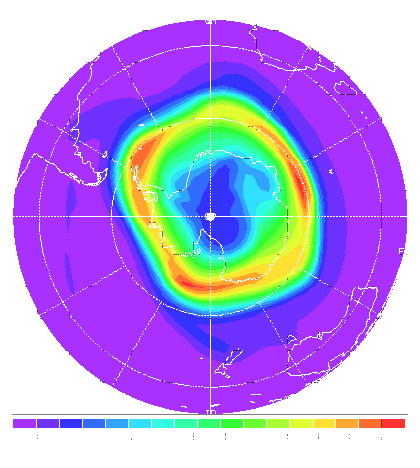

Ozone exists in two layers of the atmosphere: the stratosphere and the troposphere. Stratospheric , or “good,” ozone is essential to life on Earth, because i
, or “good,” ozone is essential to life on Earth, because i t protects DNA from the sun's UV radiation. Unfortunately, this layer of ozone is being depleted, largely due to chlorofluorocarbons (or CFCs) as refrigerants, insulating foams, and solvents. Although measures have been taken to phase out CFCs and other ozone-depleting agents, it can take years before they are naturally destroyed in the atmosphere. For example, it can take 2 to 5 years for CFCs to travel up to the stratosphere. There, they begin to break down and produce chlorine, which will react with ozone in the reactions:
t protects DNA from the sun's UV radiation. Unfortunately, this layer of ozone is being depleted, largely due to chlorofluorocarbons (or CFCs) as refrigerants, insulating foams, and solvents. Although measures have been taken to phase out CFCs and other ozone-depleting agents, it can take years before they are naturally destroyed in the atmosphere. For example, it can take 2 to 5 years for CFCs to travel up to the stratosphere. There, they begin to break down and produce chlorine, which will react with ozone in the reactions:
O3 + Cl -> ClO + O2
ClO + O -> O2 + Cl
These processes are catalytic because chlorine is regenerated, ready to react with more ozone. One chlorine atom can split as many as 100,000 ozone molecules during its stratospheric lifetime.
Ozone can also act as an atmospheric self-cleansing agent. The reaction:
O3 + hv -> O2 + O(1D)
O(1D) + H20 -> 2OH
ends with the production of OH radicals. With an unpaired electron in its outermost orbital, OH readily combines with and oxidizes compounds such as hydrocarbons, hydrogen sulfide, and carbon monoxide, which are poisonous.

In this study, we looked at the transportation of tropospheric, or ground level, ozone between continents. When ozone is in the troposphere, it is considered a pollutant because of the damage it can cause to living tissue. It is either made photochemically in the troposphere, or is transported from the stratosphere. Ozone is created photochemically through a series of complex reactions between ultraviolet light, and hydrocarbons and nitrogen oxides, which come from vehicle emissions and the combustion of other fossil fuels. Hot, sunny, calm days are ideal conditions for photochemical reactions, especially in the presence of a high pressure system that will cause an inversion cap to form in the lower atmosphere, preventing diffusion of polluted air into other parts of the atmosphere. The air is then forced to be stagnate, producing a hot, photochemical stew.
Stratospheric ozone is produced when ultraviolet light strikes an O2 molecule, splitting it into two oxygen atoms. When three single oxygen atoms collide, ozone is created. This ozone can be transported into the troposphere by way of upper layer trough and lower layer cut-off activities, as well as by Hadley circulation.
In order to study the transport of pollution between continents, TOPSE (Tropospheric Ozone Production about the Spring Equinox) measurements for 0-8 km and at latitudes of 40°-50°N over North America were used. To analyze the data, principal component analysis and positive matrix factorization methods were applied with 14 relatively long-lived chemical tracers and one dynamic tracer, potential temperature, which can be used to compare the temperatures of air masses that are at different levels in the troposphere. Basically, principal component analysis (PCA) is a method for eliminating some of the variables and for establishing relationships between variables. Positive matrix factorization (PMF) is another newer method of doing this that is less ambiguous, because it requires that every number put into the matrices to be positive value. Hence, results are more easily interpreted, and it is for this reason that the results discussed in the full length paper are PMF results. By using this methodology, air masses can be differentiated by their tracer characteristics and by their geographic origins, which can be found using back trajectories.
km and at latitudes of 40°-50°N over North America were used. To analyze the data, principal component analysis and positive matrix factorization methods were applied with 14 relatively long-lived chemical tracers and one dynamic tracer, potential temperature, which can be used to compare the temperatures of air masses that are at different levels in the troposphere. Basically, principal component analysis (PCA) is a method for eliminating some of the variables and for establishing relationships between variables. Positive matrix factorization (PMF) is another newer method of doing this that is less ambiguous, because it requires that every number put into the matrices to be positive value. Hence, results are more easily interpreted, and it is for this reason that the results discussed in the full length paper are PMF results. By using this methodology, air masses can be differentiated by their tracer characteristics and by their geographic origins, which can be found using back trajectories.
For more general information, look here to read the abstract of the paper. To view the entire paper, click on this link.